home > interesting topics > random musings > daniel
Is the Book of Daniel Prophetic or Historical?
The Bible Book of Daniel is used as a key source of proof that the Bible is inspired, based on the claim it contains remarkably accurate prophecy. This article looks at whether Daniel is prophetic or historic. The key to such determination is to identify when it was written - before or after the events that it details.
In the case of Daniel, due to the symbolic nature of its writing, it is also necessary to identify what current events it may have been referring to. Daniel is an example of apocalyptic literature, which developed in the post-exilic Jewish era, foretelling the end of oppression by foreign powers. This dangerous political message was cloaked in Religious metaphors for reasons of safety.
Watchtower points to Daniel’s discussion of world powers as proof of inspiration, and this was core to the foundation my faith was based upon. I specifically found the foretelling of world powers, and prophecy of "70 weeks" to be evidence of inspiration. The prophecy of beasts specifically name the succession of world powers in advance, and the "70 weeks" is interpreted as prophesying the arrival and death of Jesus.
Watchtower places the writing of Daniel in 536 B.C., as shown in the following Watchtower quote.
“Bible Book Number 27—Daniel
Writer: Daniel
Place Written: Babylon
Writing Completed: c. 536 B.C.E.”
All Scripture Is Inspired of God and Beneficial p.138
Watchtower identifies Daniel as the writer on the basis of it containing first person accounts by Daniel.
“That Daniel was the writer is made evident by the book itself. It reports: “In the first year of Belshazzar the king of Babylon, Daniel himself beheld a dream and visions of his head upon his bed. At that time he wrote down the dream itself. The complete account of the matters he told.” (Da 7:1) His being the writer is also apparent from the fact that chapters 7 through 12 are written in the first person.” Insight, Volume 1 p.577
This is hardly compelling evidence, and at most only indicates that Daniel may have written portions of the book that carries his name. Daniel was not written by a single writer, or even written in a single language. Daniel was written in both Aramaic and Hebrew. It opens in Hebrew, switches to Aramaic from 2:4b to 8:1, where it reverts back to Hebrew until chapter 12. Controversially, the Septuagint translation of Daniel into Greek, copies of which have been dated back to 100 B.C., also includes chapters 13 and 14 of Daniel in Greek, which are in the Catholic and East Orthodox Bible translations, but not Protestant ones.
Daniel was not finished in 536 B.C. Whilst it may have started being composed during this time, it continued being added to and redacted until between 167 and 164 B.C. There are several reasons for this conclusion.
- It is not included in the Hebrew Bible's canon of the prophets, which was closed around 200 B.C.
- The prophecies of Daniel are accurate down to the career of Antiochus IV Epiphanes, and desecration of the temple in 167 B.C, but does not mention the reconstruction of the Temple or circumstances of Antiochus' death in 164 B.C.
- Inaccuracies regarding the Babylonian and Persian periods indicate it was written at a later date
- Some of the words were not common until this later time period
- The oldest discovered manuscripts of Daniel only date back to 150 B.C.
- Daniel identifies by name the progression of world powers as Babylon, Media Persia and Greece, but not Rome
Regarding language, Daniel 3:5,7,10,15 uses the Greek words for harp, sackbut, and psalter, indicating a time of writing after the time of Alexander and Greek dominance. For instance, Daniel 3:5 uses the Greek κίθαρις instead of the Aramaic kitharos. Driver in PTR, XXV, 1927, pp. 353-388 lists around 30 expressions used in Daniel that were not in use in early literature, concluding “The verdict of the language of Daniel is thus clear... the Hebrew supports... a date after the conquest of Palestine by Alexander the Great (332 BC).” Aramaic was in use in the 6th Century BC, but not in common use until the 4th century. In The Aramaic of Daniel, Kitchen identifies that of the Aramaic used, “one-tenth remaining consists of words so far found only in sources later than the fifth Century BC (e.g. Nabataean, Palmyrene or later Aramaic dialects), or so far not attested externally at all.” Whilst scholars such as Martin in The Hebrew of Daniel, and Kitchen in The Aramaic of Daniel note that this is not proof of the period of writing, these are indications for the period of Daniel’s writing.
With this array of information to support Daniel being written and updated down until the second century B.C., it makes most of Daniel historic, and not prophetic.
Four Beastly World Powers
The first inclination that led me to research when the book of Daniel was written is that the book names three of the world powers it describes as wild beasts, but did not (or could not) name the fourth. It is a simple point, but was the first to strike me as odd if Daniel was a prophet. Daniel’s discussion of world powers is used as proof of Biblical Inspiration, specifically his ability to name those that would rise to power in the future. Yet, whilst the book of Daniel identifies by name the progression of world powers as Babylon, Media Persia and Greece, the fourth kingdom, Rome is left unnamed.
Daniel discusses 4 kingdoms or world powers, represented in visions as either beasts or a male statue.
Daniel 2 describes a statue of 4 materials.
Daniel 2:32 “The head of that image was of fine gold, its chest and its arms were of silver, its abdomen and its thighs were of copper, 33 its legs were of iron, and its feet were partly of iron and partly of clay. 34 You looked on until a stone was cut out, not by hands, and it struck the image on its feet of iron and of clay and crushed them.”
These materials represent 4 world powers.
Daniel 2:38 “… you yourself are the head of gold. 39“But after you another kingdom will rise, inferior to you; then another kingdom, a third one, of copper, that will rule over the whole earth. 40 “As for the fourth kingdom, it will be strong like iron.”
Daniel specifically names 3 of these kingdoms as Babylon, Media and Persia, and Greece, but does not name the fourth.
Daniel 2:38 “you yourself are the head of gold. 39 “But after you another kingdom will rise, inferior to you … 48 The king then elevated Daniel and gave him many fine gifts, and he made him the ruler over all the province of Babylon.”
Daniel 8:20 “The two-horned ram that you saw stands for the kings of Meʹdi·a and Persia. 21 The hairy male goat stands for the king of Greece; and the great horn that was between its eyes stands for the first king. 22 As for the horn that was broken, so that four stood up instead of it, there are four kingdoms from his nation that will stand up, but not with his power.”
Daniel does not name the fourth world power, because the writer was not able to prophesy who it would be. Daniel was being written when Greece was world power, so the writers had historical knowledge of Babylon, Media and Persia, and Greece being the succession of world powers. It did not prophesy by name which world power would come next, rather made the obvious prediction a fourth power would arrive, obvious since the death of Alexander in 323 B.C. began the decline of Greece. By 275 B.C. Rome was expanding their reach throughout the region. The writers of Daniel may have guessed Rome as the next power, because Greece had started to see Rome as a threat, shown by parts of Greece allying with Carthage against Rome in 215 B.C. Despite this, the writers did not take the gamble on predicting who the next world power would be.
Daniel 2 then goes on to discuss that this fourth power would be replaced by God’s kingdom.
Daniel 2:44 “In the days of those kings the God of heaven will set up a kingdom that will never be destroyed. And this kingdom will not be passed on to any other people. It will crush and put an end to all these kingdoms, and it alone will stand forever."
This turned out to be false prophecy, because God’s Kingdom did not replace Rome. It did not crush all kingdoms, and commence ruling the world, rather a series of political powers have continued a succession of world dominance for over 2,000 years.
In a farcical attempt to make Daniel prophetic of God’s kingdom arriving in 1914, Watchtower says that the feet of iron and clay represent Rome through some type of incarnated parade of successive kingdoms, finally represented by the Anglo/American world power.
Rome did not hand the world-power baton to England, who relinquished it to the United States of America. No, between Rome and the dominant rise of the British empire in the seventeenth century was a period of one thousand years where a number of prominent countries left their mark on the world. Rome's collapse was at the hands of Islamic states, with Muslim caliphates becoming dominant between the 7th and 10th centuries.
Watchtower never mentions the Mongol Empire in relation to Daniel prophecy, despite it stamping itself as one of the great world powers during the 13th and 14th century by becoming the largest contiguous land empire ever, with reach throughout Europe, Asia and the Iranian Peninsula, crossing the same region of the other world powers of Daniel.
Later there rose up the Spanish, Portuguese, French, Dutch and Ottoman empires. It was only after this huge expanse of time that Britain began to dominate, becoming the largest empire ever. Yet it was only the foremost "world power" for a century, before fading in the shadow of America. There is certainly no connection between Rome and the Anglo/American world powers, separated by over a millennium of time.
Applying Watchtower’s time scale to Daniel’s image creates a pair of disproportionately long legs. The time range of the first 3 kingdoms was from Babylon’s ascension in 626 B.C., to the end of the domination of Greece in 146 B.C. is only 480 years. To say the fourth kingdom extended from 146 B.C. to 2018 A.D. (and counting) means the fourth kingdom represented by the legs cover a period of over 2,100 years. Therefore the three kingdoms of the statue's head and torso covered 480 years, whilst the legs represent a kingdom spanning 2,100 years. As already discussed, history shows that there was no such 2,100 year world power.
King of the North, King of the South
In a bid to add credence to its interpretation of the image, Watchtower goes on to align the legs from the image with the King of the North and King of the South from Daniel 11.
Just as the legs of the image was about a single world power, the King of the North and South from Daniel 11 is the historical recount of the wars between the Ptolemies of Egypt and the Seleucids of Syria, which directly affected Jerusalem, wedged between Syria and Egypt.
Verse 21 deals with Antiochus, who reigned 175-164 B.C.E. Antiochus removed Israel's High Priest Onias III, as referred to in verse 22 and an antagonist described as "the contemptible person to whom royal majesty has not been given."
Daniel 12 continues the account, with a prophetic description of the hope for the restoration of the Jewish kingdom at the hands of a Messiah.
Borrowing from the tradition of Protestantism adding a modern day fulfilment to historical Biblical passages, Watchtower presents its own eccentric millennialist interpretation. It claims that where Daniel says King, it is not referring to a King, but a range of Kings and Kingdoms and two millennium of rulers and various forms of government. Several Middle Eastern, European and American countries are cherry picked to represent the King’s of North and South as world powers, with little regard for historical accuracy, or the vast periods of time in between.
“TWO rival kings are locked in an all-out struggle for supremacy. As the years pass, first one, then the other, gains ascendancy. At times, one king rules supreme while the other becomes inactive, and there are periods of no conflict. But then another battle suddenly erupts, and the conflict continues. Among the participants in this drama have been Syrian King Seleucus I Nicator, Egyptian King Ptolemy Lagus, Syrian Princess and Egyptian Queen Cleopatra I, Roman Emperors Augustus and Tiberius, and Palmyrene Queen Zenobia. As the conflict nears its end, Nazi Germany, the Communist bloc of nations, the Anglo-American World Power, the League of Nations, and the United Nations have also been involved. The finale is an episode unforeseen by any of these political entities.” Pay Attention To Daniel’s Prophecy! ch.13 p.211
The explanation from the Daniel book shows Watchtower recognises the correct understanding that this passage regards the wars between Syria and Egypt. Yet within a sentence, it has added an extra 2,000 years to include Nazis and Communism.
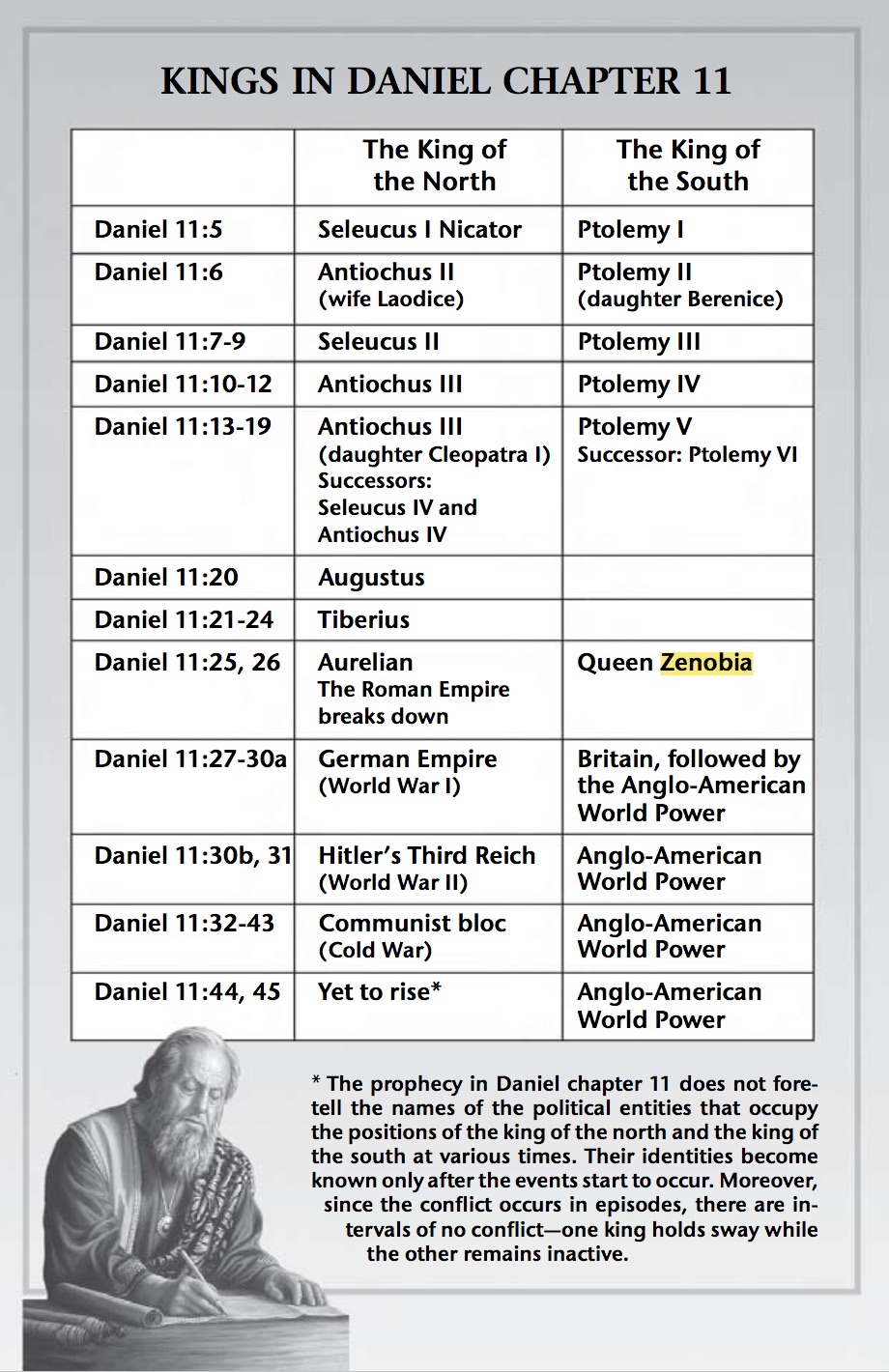
Pay Attention to Daniel's Prophecy p.284
In the above image, Aurelian appears to hand the baton to The Germanic Empire. Aurelian lived in the third century. There is no attempt to explain the large gap in time between the decline in the Roman empire, and the nineteenth century rise in conflict between the German and British empires. Once more, the domination of the Spanish, Portuguese, French, Dutch, Mongol and Ottoman empires over the last two millennium are ignored.
One obvious omission from Watchtower's mention of world powers is China. China does not receive inclusion as of any note during this time, despite its grandeur and importance to world events. A 1961 mention including modern China under Communism's representation of the King of the North is the closest China gets to being included as of Biblical significance.
“Are not Red China’s holy days celebrated beneath towering portraits of Mao Tse-tung and other Communist idols? This is the same kind of worship that marked the founding of Babylon, when the militaristic Nimrod, who “displayed himself a mighty hunter in opposition to Jehovah,” was exalted as “god” and dictator in Babylon. (Gen. 10:9, 10) In the same way modern communism, as the “king of the north” of Bible prophecy, ‘speaks marvelous things against the God of gods’ and honors “the god of fortresses” by amassing a terrible array of nuclear armaments. (Dan. 11:36, 38) The spirit of proud Babylon is perpetuated in the not-so-godless Red religion of communism.” Watchtower 1961 Feb 15 p.104
The primary contenders following the Roman empire are presented as being the Germanic and British Empires. Then, with the stroke of a pen, they are replaced by the United States and Soviet Union.
"During the two world wars, Germany had been the chief enemy of the king of the south—the Anglo-American World Power—and had occupied the position of the king of the north. After World War II, however, that nation stood divided. West Germany became an ally of the king of the south, and East Germany aligned it- self with another powerful entity—the Communist bloc of nations headed by the Soviet Union. This bloc, or political entity, stood up as the king of the north, in strong opposition to the Anglo-American alliance. And the rivalry between the two kings became a Cold War that lasted from 1948 to 1989." Pay Attention to Daniel's Prophecy p.270
The "King of the North" (not Kings) referred to the Seleucids of Syria, whilst the King of the South was the Ptolemies of Egypt. This theme runs through Daniel 11. In a desperate attempt to have a secondary fulfilment, Watchtower presents USA as Egypt, as part of their line of King-of-the-South world power replacements.
"Jehovah’s angel continued: “He [the king of the north] will keep thrusting out his hand against the lands; and as regards the land of Egypt, she will not prove to be an escapee. And he will actually rule over the hidden treasures of the gold and the silver and over all the desirable things of Egypt. And the Libyans and the Ethiopians will be at his steps.” (Daniel 11:42, 43) Even the king of the south, “Egypt,” did not escape the effects of the expansionist policies of the king of the north. For example, the king of the south suffered a notable defeat in Vietnam." Pay Attention to Daniel's Prophecy pp.279-280
When the Soviet Union was disbanded, Watchtower was unable to confirm who the King of the North was. I recall conversations that it could be the Islamic states, or China, both who were rising in prominence on the world scene. Watchtower tried to quell such speculation.
"With the disbanding of the Soviet Union in December 1991, the king of the north suffered a serious setback. Who will be this king when Daniel 11:44, 45 is fulfilled? Will he be identified with one of the countries that were part of the former Soviet Union? Or will he change iden- tity completely, as he has done a number of times before? Will the development of nuclear weapons by additional nations result in a new arms race and have a bearing on the identity of that king? Only time will provide answers to these questions. We are wise not to speculate. When the king of the north embarks on his final campaign, the fulfillment of prophecy will be clearly discerned by all who have Bible-based insight." Pay Attention to Daniel's Prophecy p.281
Daniel 11 is not difficult to understand, and it would seem unlikely that people would fall for Watchtower's interpretation that takes a 2000 year old historical event, and gives it a prolonged and illogical millennia extension. Yet Watchtower followers enthusiastically lap it up, and as the years pass and Trump and Putin are replaced without triggering Armageddon, will eagerly wait the next Watchtower instalment.
Messiah and the 70 Weeks
Most important to me was the "70 weeks" of Daniel 9, which is commonly applied to the coming of Jesus the Messiah. There is no doubt that Daniel was written prior to the formation of Christianity in the first century AD, and hence holds the most compelling evidence of prophetic inspiration.
First to note is that Messianic prophecies are not proof of inspiration, since they have no collaborative support, and the New Testament writers could have falsified the story of Jesus to fit the prophecy, On the other hand, the "70 weeks" did appear uniquely prophetic of the arrival and sacrifice of Jesus.
The application of this passage was not originally to the arrival of Jesus, but rather Antiochus IV. The "70 weeks" was only interpreted as a Messianic prophecy decades after Jesus’ death.
Recognition of the period of time during which Daniel was written places the events described during the final writer’s time. The "70 weeks" relates to the period ending with the invasion of Antiochus IV. “Messiah the Prince” refers to an anointed one, and is not a term exclusive to Jesus. In Daniel 9, the Anointed Prince was not a liberator, but a destroyer, removing the rightful High Priest and replacing him with his own brother.
Whilst there is no single consensus as to exactly what each statement was taken to refer to, the following summary outlines the main aspects.
- The “anointed” that marks the beginning of the 62 weeks was Jeshua, the first high priest of the restored priesthood under Zerubabbel.
- The "anointed" whose departure marks the end of the 62 weeks referred to the assassiation of Onias III in 170 B.C., the last "legitimate" high priest.
- Messiah the Prince involved in the desolation of the city in and desecration of the temple in 167 B.C. was Antiochus IV.
- The Abomination of Desolation was in installation of the heathen altar on 15 Chislev 167 B.C.
- Antiochus IV died in 164 BC.
The Desolation of Babylon
Support for the idea that Daniel was not prophetic are Bible prophecies that did not come true.
Most significant are prophecies that the destruction of Babylon would lead to it being totally desolate and never being inhabited, which did not occur.
Both Jeremiah and Isaiah prophesied that after the fall of Babylon, it would never again be inhabited.
Jeremiah 50
13 - Because of the indignation of Jehovah she will not be inhabited;
She will become utterly desolate.
Anyone passing by Babylon will stare in horror
And whistle because of all her plagues
Jeremiah 51
37 And Babylon will become piles of stones, A lair of jackals, An object of horror and something to whistle at, Without an inhabitant. …
43 Her cities have become an object of horror, a waterless land and a desert. A land where no one will live and where no man will pass through. …
61 Furthermore, Jeremiah said to Se·raiʹah: “When you come to Babylon and see her, you must read aloud all these words. 62 Then say, ‘O Jehovah, you have said against this place that it will be destroyed and left without an inhabitant, man or beast, and that she will become desolate forever.’ 63 And when you finish reading this book, tie a stone to it and throw it into the middle of the Eu·phraʹtes. 64 Then say, ‘This is how Babylon will sink down and never rise again because of the calamity that I am bringing on her; and they will grow weary.’”
Isaiah 13
1 A pronouncement against Babylon that Isaiah the son of Aʹmoz saw in vision: …
19 And Babylon, the most glorious of kingdoms, The beauty and the pride of the Chal·deʹans, Will be like Sodʹom and Go·morʹrah when God overthrew them.+20 She will never be inhabited,Nor will she be a place to reside in throughout all generations. No Arab will pitch his tent there,And no shepherds will rest their flocks there.21 The desert creatures will lie down there;Their houses will be filled with eagle owls.The ostriches will reside there, And wild goats* will skip about there.22 Howling creatures will cry out in her towers,And jackals in her luxurious palaces.Her time is near, and her days will not be prolonged.”
This failed to come true, as Babylon has remained inhabited up until today. After it fell to the Persians it remained inhabited. At one point, Alexander the Great rebuilt it into an important and strategic city that became a centre of learning and commerce. In fact, the Apostle Peter was in Babylon with other Christians when writing the book of 1 Peter.
1 Peter 5:13 - She who is in Babylon, a chosen one like you, sends you her greetings, and so does Mark, my son.
It was over a thousand years after Cyrus conquered Babylon that it was reduced to a city containing just a few hundred villagers, and even then, the statement that “She will never be inhabited, Nor will she be a place to reside in throughout all generations.” did not come true.
History of Babylon
See https://en.wikipedia.org/wiki/Babylon
After the Muslim conquest, it continued to remain inhabited by several hundred villagers, and in the 18th century several villages were established within the walls of Babylon. Presently, thousands of people live within the perimeter of the ancient city walls, and the city is visited by tens of thousands of tourists each year.
Isaiah 13 prophesied that Babylon would become “like Sodom and Gomorrah.” Whereas Sodom and Gomorrah were completely destroyed and lost, with archaeologists undecided as to where they even were, Babylon is well known and inhabited.
A 1905 map shows the location of villages spread throughout the walls of Babylon.
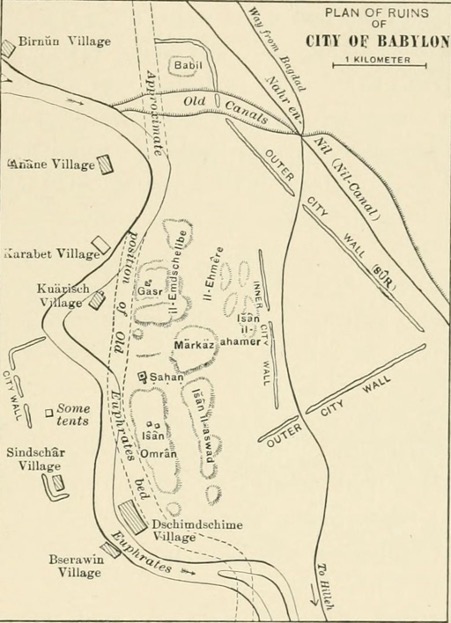
Plan of Babylon outlining the villages in 1905, the largest having 200 inhabitants.
How do Christian groups justify their claims that the destruction of Babylon was accurate prophecy? Some honestly admit the desolation has not yet come, weakly contending the prophecy will be fulfilled in the future.
“So, has this kingdom of Babylon become like Sodom and Gomorrah as prophesied in Isaiah and Jeremiah? Not yet, but that day is coming soon, ... " thehouseofdavid.org/writings/2021/5/1/the-mystery-of-baylon (As of 12 March 2024)
An alternative approach is to point to what did occur in 539 B.C. The overthrow of Babylon by the Persians in 539 B.C. removed Nabonidus, the last king of Babylon, after which Babylon ceased to be a world power. This is pointed to by some Christians as fulfilling the prophecy.
"In Isaiah 13:19, the prophet said Babylon would be overthrown, permanently. History confirms that when Cyrus conquered Babylon in 539 BC, it never again rose to power as an empire." aboutbibleprophecy.com/isaiah_13_19.htm (As of 12 March 2024)
Whilst there is an attempt to make justify how Isaiah and Jeremiah is accurate prophecy, their justifications are inadequate, and Isaiah and Jeremiah stated in no uncertain terms that the fall of Babylon to the Persians would result in no one ever living in Babylon again. The attempt to bend the words of those prophets to mean that Babylon would no longer be a world power, or their declarations would come true at some future time is not what those Scriptures say.
Watchtower takes a far more dishonest approach when dealing with this issue, not only skirting over the failure of this prophecy, but claiming it came true. The Governing Body must hope Jehovah’s Witnesses will take their word as gospel and not research for themselves.
For instance, Life and Ministry Meeting Workbook, June 2017 unashamedly uses this prophecy to claim “Jehovah precisely foretold future events.”
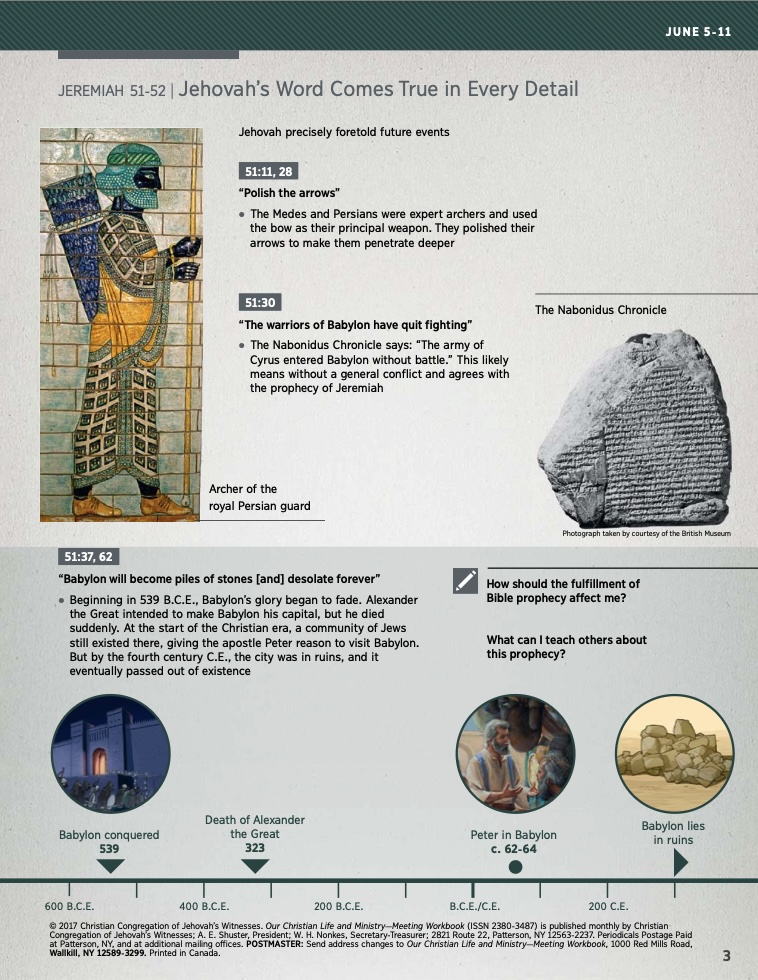
Jeremiah 51 Life and Ministry June 2017 mwb_E_201706.pdf
Watchtower articles admit that Babylon continued to be inhabited for centuries after its destruction, but fail to mention this is not what was prophesied, or that Babylon is still inhabited.
“Centuries later, Jesus’ apostle Peter came to teach a Jewish community that flourished here, and it was from Babylon that Peter wrote at least one of his inspired Bible letters. (1 Peter 5:13) In the course of time, however, the prophecy was fulfilled: “And Babylon, the decoration of kingdoms, the beauty of the pride of the Chaldeans, must become as when God overthrew Sodom and Gomorrah. She will never be inhabited.”—Isaiah 13:19, 20. Today, mighty Babylon is nothing but dusty piles of stones, ruins in a wasteland—a silent and eloquent testimony to the unfailing accuracy of Jehovah’s prophetic Word.—Jeremiah 51:36, 37." – Watchtower 1988 Mar 1 p.31
"In the eighth century B.C.E., the Bible writer Isaiah declared that Babylon—which was only later to become the capital of a powerful empire—would be overthrown and eventually become uninhabited. (Isaiah 13:17-20) … Did Babylon become uninhabited? For some centuries, people continued living there. But today, Babylon’s ruins—near Baghdad, Iraq—testify to the prophecy’s complete fulfillment. Yes, the Bible is reliable even when it discusses future events." Watchtower No.1 2020 p.8
"Rebuilding of Babylon Stalled
Ancient Babylon, the famed city of King Nebuchadnezzar with its hanging gardens, collapsed under the onslaught of conquerors more than 2,500 years ago. A much smaller Babylon survived until about the fourth century C.E., when it became a complete ruin. Modern-day Iraq recently planned to rebuild the former citadel of imperial power to its grandeur of old. (See Awake! of March 8, 1988, page 30.) However, recent political events in the Middle East have put a restraint on such construction plans, reports The New York Times. Isaiah 13:19, 20 sets forth an interesting prophecy on Babylon’s doom, stating that “she will never be inhabited, nor will she reside for generation after generation.” - Awake 1991 Jan 8 p.29
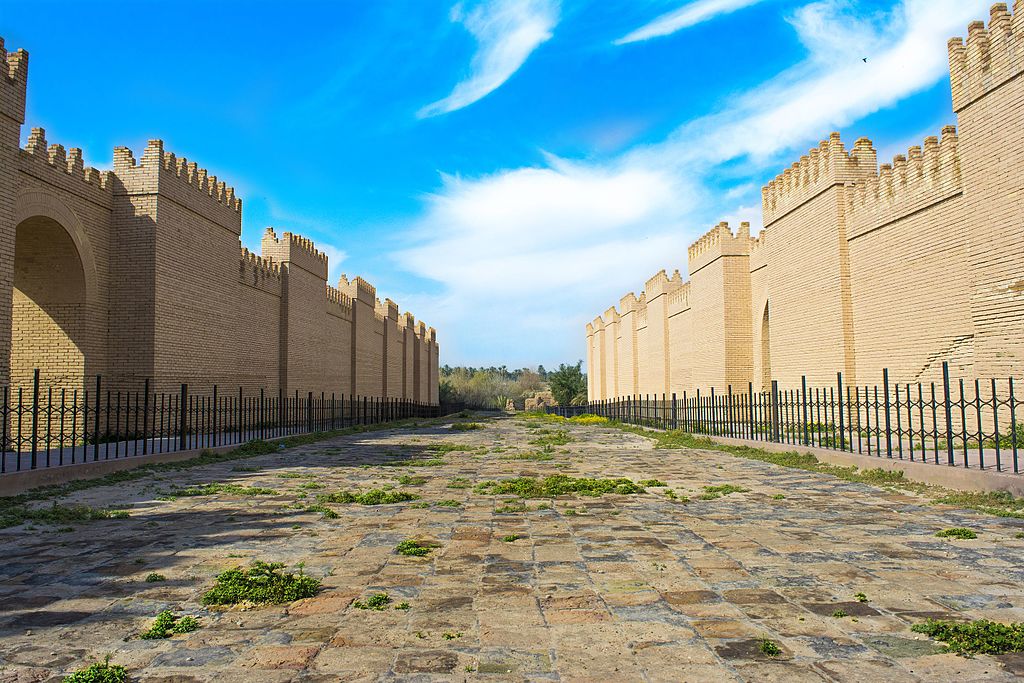
Babylon Street - Attribution: Osama Sarm
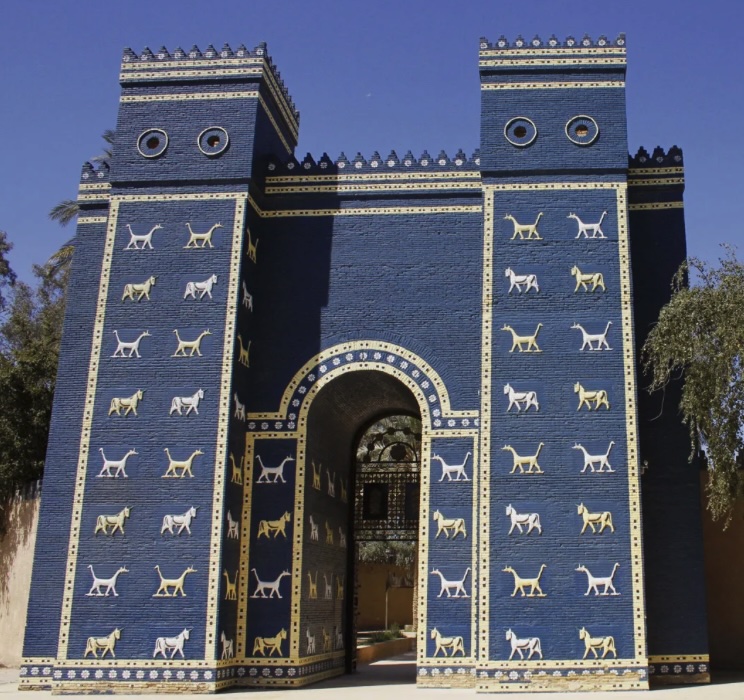
Saddam Hussein rebuilt many of Babylon’s grand structures, which remain as a popular tourist attraction.

During the war with Iraq, American troops set up camp in Babylon.
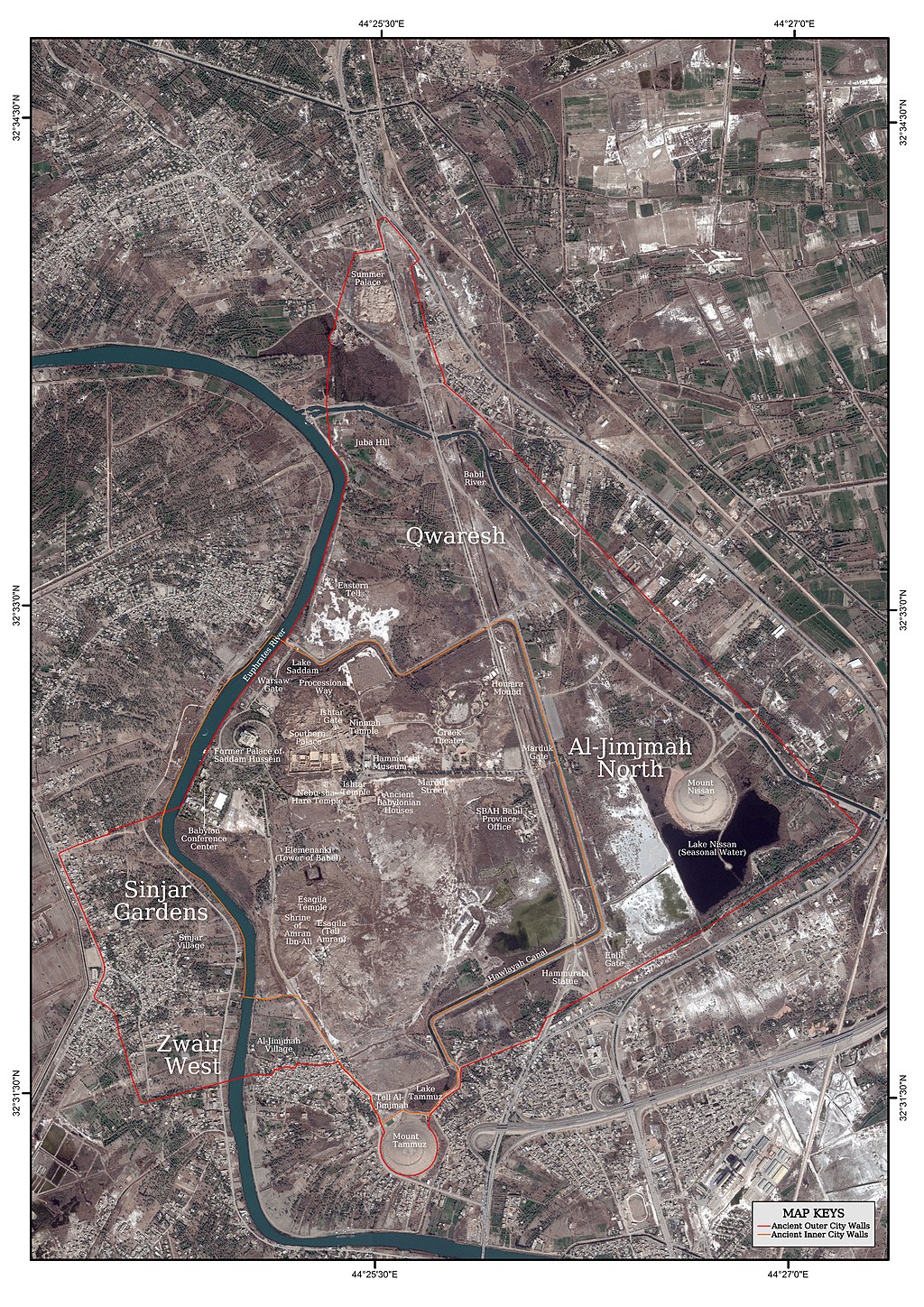
Map of major areas and villages in Babylon in 2014.
Babylon remains inhabited and testament that the Bible is not a book of prophecy.
Conclusion
Some Protestant groups interpret certain Bible accounts as having a primary fulfilment at the time of writing, and a second fulfilment in modern times; that is, the time period they were living in. Watchtower takes this approach, though inconsistently when applied to Daniel. For instance:
- the beasts, and the seventy weeks, only have a single ancient application
- the Seven Times is given two applications - Nebuchadrezzar and the end of the Gentile times
- the kings of the north and south have just a single ongoing application
In the Tanakh (Hebrew Bible), the book of Daniel is not included as part of the Neviim (Prophets), but rather in the Ketuvim (Writings). Evidence that it was completed around 164 B.C. show it to be a mostly a historical account, rather than prophetic.
The book of Daniel ends with a positive prophetic message that God’s kingdom would replace the final kingdom, the Roman empire. This did not happen as expected, and the coming of God's Kingdom is an event still hoped for 2,000 years later.
Daniel is not a prophetic book. Due to the book of Daniel being constantly revised up until the second century BC, what it presents are partially embellished historical events. This applies to the Old Testament in general. Specific statements, though sometimes written as if prophetic, can be shown to have been written after the events happened.
The Bible is not a prophetic book. Whilst it contains vague and obvious statements about the future, such are there being wars, famine, pestilence, and earthquakes, these are not prophetic; these events were a common and constant occurrence for the Bible writers. These writers did not mention things uncommon in their local area, showing no knowledge of disasters occurring in the rest of the world, such as cyclones, tornados, tsunamis, and wildfires. They showed no ability to foretell the future, failing to predict the population explosion since the 1800s, the development of the nuclear threat in the 20th century, or global warming in the 21st century.
Most conclusive are prophecies that have proven false, such as the ongoing residency of people at Babylon, despite two prophets declaring the city would be completely uninhabited after its destruction.
Footnotes -
K.A. Kitchen, “The Aramaic of Daniel,” D. J. Wiseman, ed., Notes on Some Problems in the Book of Daniel. London: The Tyndale Press, 1965. pp. 31-79.
W. J. Martin, “The Hebrew of Daniel,” D. J. Wiseman, ed., Notes on Some Problems in the Book of Daniel. London: The Tyndale Press, 1965. pp. 28-30
For detailed information on Daniel, see the Wikipedia article Book of Daniel (14 Aug 2018. This provides a comprehensive discussion backed up by a large number of references. The article Prophecy of Seventy Weeks likewise lists various viewpoints as to the interpretation. One of the impressive aspects of the Book of Daniel is its use of Chiastic structure as a literary technique.
Written July 2018, latest update March 2024.
![]() Paul Grundy 2005 - 2026
Paul Grundy 2005 - 2026
